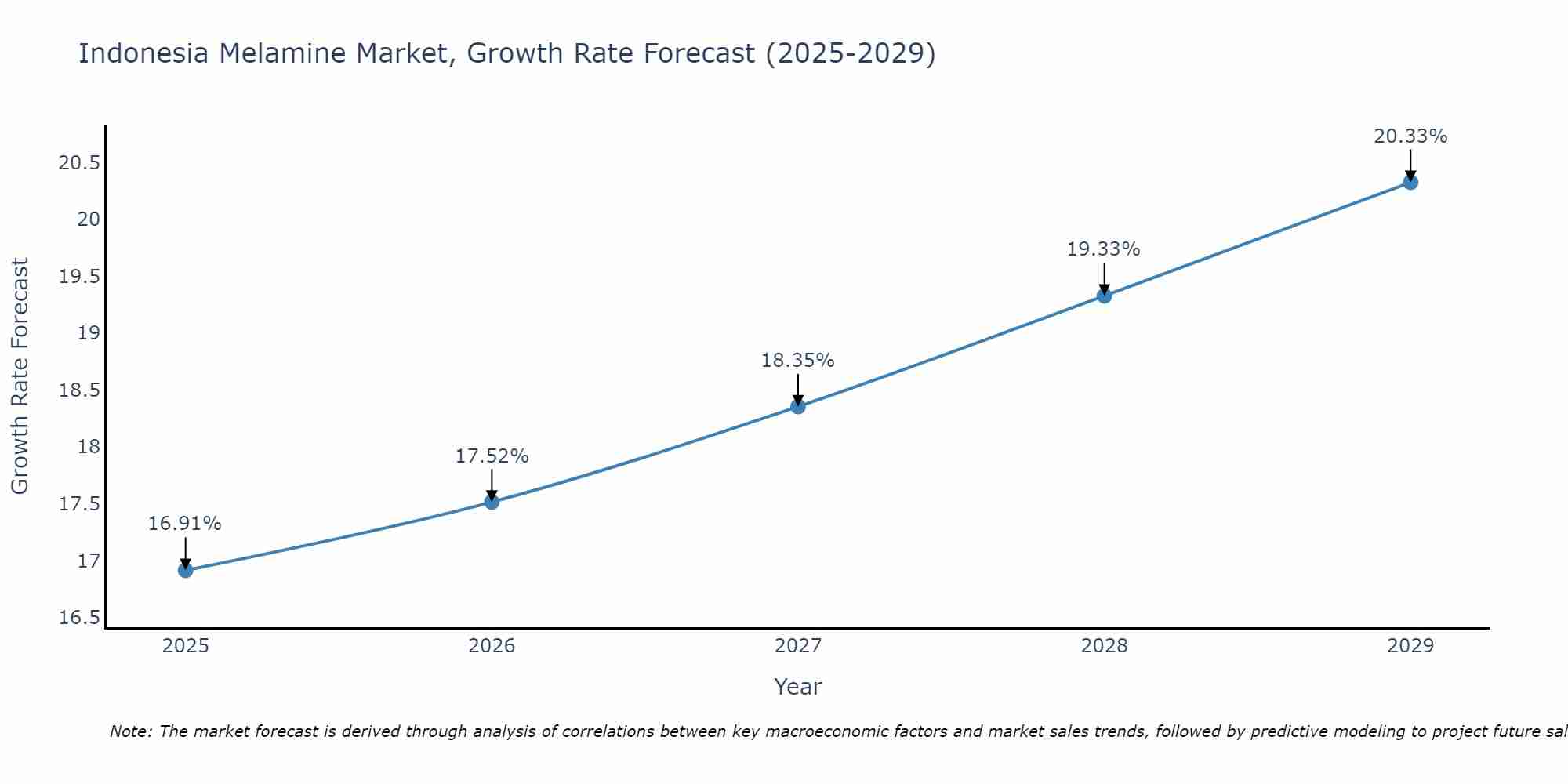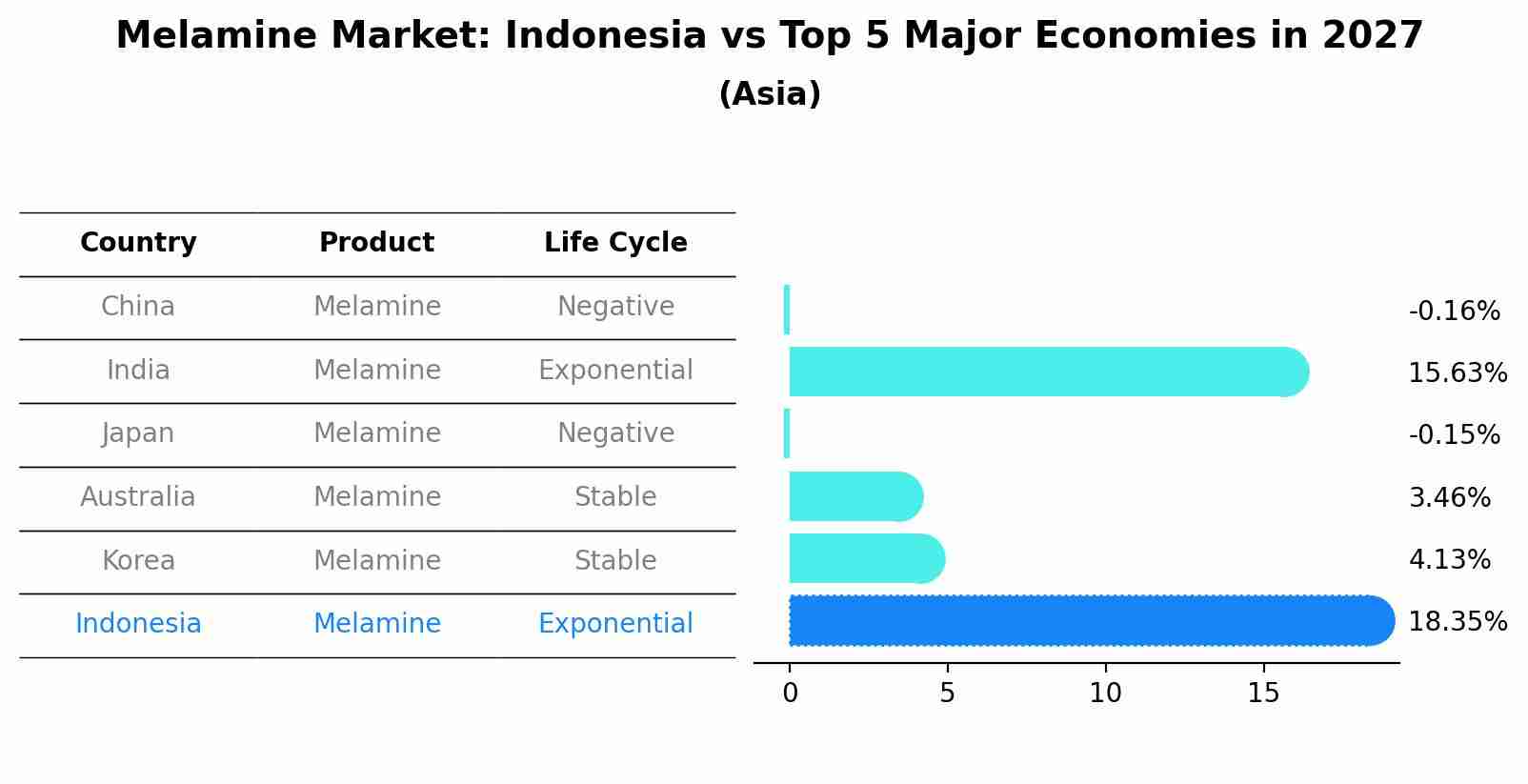Indonesia Melamine Market (2025-2031) Outlook | Growth, Revenue, Value, Analysis, Industry, Share, Companies, Forecast, Size & Trends
| Product Code: ETC092027 | Publication Date: Jul 2023 | Updated Date: Apr 2025 | Product Type: Report | |
| Publisher: 6Wresearch | No. of Pages: 70 | No. of Figures: 35 | No. of Tables: 5 | |
Indonesia Melamine Market Size Growth Rate
The Indonesia Melamine Market is poised for steady growth rate improvements from 2025 to 2029. Commencing at 16.91% in 2025, growth builds up to 20.33% by 2029.

Melamine Market: Indonesia vs Top 5 Major Economies in 2027 (Asia)
Indonesia's Melamine market is anticipated to experience a exponential growth rate of 18.35% by 2027, reflecting trends observed in the largest economy China, followed by India, Japan, Australia and South Korea.

Indonesia Melamine MarketSynopsis
Indonesia is a major producer of melamine, which is widely used in the production of dinnerware, utensils and furniture. The country has been able to make use of its abundant raw material resources to become one of the leading producers and exporters of melamine worldwide. Indonesia melamine industry encompasses several sectors including food packaging, industrial resins and coatings as well as construction material such as laminates.
Market Trends
The growth potential for the Indonesia melamine market can be attributed to increasing demand from end-user industries like automobiles, electronics and appliances manufacturing. Additionally, growing investments in infrastructure projects across Indonesia have also created opportunities for melamine manufacturers in the country. An increase in disposable incomes among Indonesias has further boosted consumer spending on household products made with high quality materials such as those containing melamine resins that are both fire retardant yet relatively cheap when compared to other materials like ceramic or porcelain ware products.
Market Drivers
One key factor driving growth in the Indonesia melamine market is government initiatives aimed at encouraging local businesses to invest more into R&D activities so as to develop innovative applications using this versatile material ? these include flexible packaging solutions that can be folded without compromising on its properties; medical equipment components ; building insulation systems etc. Similarly, an increase in foreign direct investment (FDI) by multinational corporations looking towards tapping into Indonesia vast natural resources, especially minerals deposits found here, will further propel this sector?s prospects over time.
COVID-19 Impact on the Market
The COVID-19 pandemic has had a significant impact on the Indonesia melamine market. Due to the disruption in supply chains, production activities have been severely hampered and demand for melamine products has declined significantly. This has caused price fluctuations in the market, which is expected to further increase as the pandemic continues. In addition, exports of melamine from Indonesia have also been affected by global lockdowns and trade restrictions imposed by various countries due to COVID-19.
Challenges of the Market
The major challenge faced by players operating in this market is increasing competition from other regional players such as China and India. The lack of local manufacturing capabilities limits the availability of high quality products at competitive prices in Indonesia, providing an advantage to foreign manufacturers who can offer more cost-effective options with better quality materials than Indonesia producers. Additionally, environmental regulations regarding emissions from production processes are becoming stricter globally; however for many Indonesia companies they remain lax or nonexistent making it difficult to comply with international standards. Furthermore, low consumer awareness about product offerings could restrict growth opportunities for domestic suppliers of melamine products within this market segment.
Industry Key Players
Some key players operating within the Japanese Melamine Market include PT Desainti Pratama Jaya Gresik (DPJ), Alkemika Indotama Kayu Putih (AIKP), PT Surya Anugerah Plastindo Asli (SAPA), Sakamoto Chemical Industry Co., Ltd., Kao Corporation and Mitsui Chemicals Incorporated among others.
Key Highlights of the Report:
- Indonesia Melamine Market Outlook
- Market Size of Indonesia Melamine Market, 2024
- Forecast of Indonesia Melamine Market, 2031
- Historical Data and Forecast of Indonesia Melamine Revenues & Volume for the Period 2021-2031
- Indonesia Melamine Market Trend Evolution
- Indonesia Melamine Market Drivers and Challenges
- Indonesia Melamine Price Trends
- Indonesia Melamine Porter's Five Forces
- Indonesia Melamine Industry Life Cycle
- Historical Data and Forecast of Indonesia Melamine Market Revenues & Volume By Forms for the Period 2021-2031
- Historical Data and Forecast of Indonesia Melamine Market Revenues & Volume By Melamine Resin for the Period 2021-2031
- Historical Data and Forecast of Indonesia Melamine Market Revenues & Volume By Melamine Foams for the Period 2021-2031
- Historical Data and Forecast of Indonesia Melamine Market Revenues & Volume By Applications for the Period 2021-2031
- Historical Data and Forecast of Indonesia Melamine Market Revenues & Volume By Laminates for the Period 2021-2031
- Historical Data and Forecast of Indonesia Melamine Market Revenues & Volume By Wood Adhesives for the Period 2021-2031
- Historical Data and Forecast of Indonesia Melamine Market Revenues & Volume By Surface Coatings for the Period 2021-2031
- Historical Data and Forecast of Indonesia Melamine Market Revenues & Volume By Thermoset Plastics for the Period 2021-2031
- Historical Data and Forecast of Indonesia Melamine Market Revenues & Volume By End-users for the Period 2021-2031
- Historical Data and Forecast of Indonesia Melamine Market Revenues & Volume By Construction for the Period 2021-2031
- Historical Data and Forecast of Indonesia Melamine Market Revenues & Volume By Chemical for the Period 2021-2031
- Historical Data and Forecast of Indonesia Melamine Market Revenues & Volume By Textile for the Period 2021-2031
- Historical Data and Forecast of Indonesia Melamine Market Revenues & Volume By Automotive for the Period 2021-2031
- Indonesia Melamine Import Export Trade Statistics
- Market Opportunity Assessment By Forms
- Market Opportunity Assessment By Applications
- Market Opportunity Assessment By End-users
- Indonesia Melamine Top Companies Market Share
- Indonesia Melamine Competitive Benchmarking By Technical and Operational Parameters
- Indonesia Melamine Company Profiles
- Indonesia Melamine Key Strategic Recommendations
Frequently Asked Questions About the Market Study (FAQs):
- Single User License$ 1,995
- Department License$ 2,400
- Site License$ 3,120
- Global License$ 3,795
Search
Related Reports
- Portugal Electronic Document Management Market (2025-2031) | Strategy, Consumer Insights, Analysis, Investment Trends, Opportunities, Growth, Size, Share, Industry, Revenue, Segments, Value, Segmentation, Supply, Forecast, Restraints, Outlook, Competition, Drivers, Trends, Demand, Pricing Analysis, Competitive, Strategic Insights, Companies, Challenges
- France Electronic Document Management Market (2025-2031) | Strategy, Consumer Insights, Analysis, Investment Trends, Opportunities, Growth, Size, Share, Industry, Revenue, Segments, Value, Segmentation, Supply, Forecast, Restraints, Outlook, Competition, Drivers, Trends, Demand, Pricing Analysis, Competitive, Strategic Insights, Companies, Challenges
- Portugal Occupational Health & Safety Services Market (2025-2031) | Strategy, Consumer Insights, Analysis, Investment Trends, Opportunities, Growth, Size, Share, Industry, Revenue, Segments, Value, Segmentation, Supply, Forecast, Restraints, Outlook, Competition, Drivers, Trends, Demand, Pricing Analysis, Competitive, Strategic Insights, Companies, Challenges
- Netherlands Occupational Health and Safety Services Market (2025-2031) | Strategy, Consumer Insights, Analysis, Investment Trends, Opportunities, Growth, Size, Share, Industry, Revenue, Segments, Value, Segmentation, Supply, Forecast, Restraints, Outlook, Competition, Drivers, Trends, Demand, Pricing Analysis, Competitive, Strategic Insights, Companies, Challenges
- Belgium and Luxembourg Facility Management Market (2025-2031) | Strategy, Consumer Insights, Analysis, Investment Trends, Opportunities, Growth, Size, Share, Industry, Revenue, Segments, Value, Segmentation, Supply, Forecast, Restraints, Outlook, Competition, Drivers, Trends, Demand, Pricing Analysis, Competitive, Strategic Insights, Companies, Challenges
- Russia Women Intimate Apparel Market (2025-2031) | Strategy, Consumer Insights, Analysis, Investment Trends, Opportunities, Growth, Size, Share, Industry, Revenue, Segments, Value, Segmentation, Supply, Forecast, Restraints, Outlook, Competition, Drivers, Trends, Demand, Pricing Analysis, Competitive, Strategic Insights, Companies, Challenges
- Africa Chocolate Market (2025-2031) | Size, Share, Trends, Growth, Revenue, Analysis, Forecast, industry & Outlook
- Global Hydroxychloroquine And Chloroquine Market (2025-2031) | Industry, Trends, Size, Outlook, Growth, Value, Companies, Revenue, Analysis, Share, Forecast
- Saudi Arabia Plant Maintenance Market (2025-2031) | Industry, Size, Growth, Revenue, Value, Companies, Forecast, Analysis, Share & Trends
- Taiwan Electric Truck Market (2025-2031) | Outlook, Industry, Revenue, Size, Forecast, Growth, Analysis, Share, Companies, Value & Trends
Industry Events and Analyst Meet
Our Clients
Whitepaper
- Middle East & Africa Commercial Security Market Click here to view more.
- Middle East & Africa Fire Safety Systems & Equipment Market Click here to view more.
- GCC Drone Market Click here to view more.
- Middle East Lighting Fixture Market Click here to view more.
- GCC Physical & Perimeter Security Market Click here to view more.
6WResearch In News
- Doha a strategic location for EV manufacturing hub: IPA Qatar
- Demand for luxury TVs surging in the GCC, says Samsung
- Empowering Growth: The Thriving Journey of Bangladesh’s Cable Industry
- Demand for luxury TVs surging in the GCC, says Samsung
- Video call with a traditional healer? Once unthinkable, it’s now common in South Africa
- Intelligent Buildings To Smooth GCC’s Path To Net Zero













